A Techno-Economic Study of an Entirely Renewable Energy-Based Power Supply for North America for 2030 Conditions
Abstract
:1. Introduction
- the power transmission system and electricity trade of different sub-regions of North America;
- an optimal energy system design taking into account available RE resources within the region;
- synergistic effects among different resources and sub-regions leading to higher efficiency of the power sector.
2. Materials and Methodology
2.1. Input Data and Resource Potential
2.2. Applied Technologies
- Technologies converting renewable resources into electricity that are used in this model are as follows: solar PV (single-axis tracking plants, ground-mounted and distributed rooftop systems), onshore wind turbines, concentrating solar thermal power (CSP), hydropower (run-of-river and dam), geothermal energy, biomass plants (solid biomass and biogas) and waste-to-energy power plants.
- Energy storage technologies are lithium-ion batteries, thermal energy storage (TES), pumped hydro storage (PHS), adiabatic compressed air energy storage (A-CAES) and power-to-gas (PtG) technology. PtG includes synthetic natural gas (SNG) with the respective synthesis technologies: methanation, water electrolysis, gas storage, CO2 scrubbing from air and both combined and open cycle gas turbines (CCGT, OCGT). Additionally, there is a 48 h biogas buffer storage and a part of the biogas can be upgraded to biomethane and injected into the gas storage.
- The energy sector bridging technologies enable additional flexibility to the energy system and consequently reduce the overall cost. PtG is a bridging technology in the energy model for production of gas for the industrial sector. The role of PtG is different as an energy sector bridging technology compared to a storage technology for the electricity sector. The second bridging technology is SWRO desalination, which connects the water sector to the electricity sector.
- The power transmission technologies have two levels: electric power distribution and transmission through the sub-regions. They are generally based on standard alternating current (AC) grids, which are not part of the model, and inter-regional transmission grids modelled by applying HVDC technology. Power losses in the HVDC grids includes two major components: length dependent electricity losses of the power lines and losses in the converter stations at the interconnection with the AC grid, as shown in Table S4 in the Supplementary Materials.
3. Scenario Assumptions
3.1. Regions Subdivision and Grid Structure
- Region-wide energy system, where all the sub-regions cover their demand through their own generation (no HVDC grid interconnections);
- Country-wide energy system, where the sub-regions are interconnected by HVDC grids and excess electricity of the regions can be transferred to the neighbouring regions within the borders of countries;
- Area-wide energy system, where the country-wide energy system is interconnected by power transmission lines;
- Integrated scenario has the same structure as the area-wide energy system scenario, but with additional non-energetic industrial gas and SWRO desalination demand. RE together with PtG technology are considered for electricity generation and storage, as well as energy sector bridging technologies to cover industrial gas and water desalination demand.
3.2. Feed-In for Solar and Wind Energy
3.3. Limits for Minimum and Maximum Installed Capacities for all Energy Technologies
3.4. Load Profile
4. Results
5. Discussion
5.1. Interpretation of Findings
5.2. The Benefits of Sectors Integration
5.3. A Comparison Between the Analysed Scenarios and a Business as Usual Scenario
5.4. Comparison of Our Results with Other Studies
6. Conclusions
Supplementary Materials
Acknowledgments
Author Contributions
Conflicts of Interest
Abbreviations
| AC | alternating current |
| A-CAES | adiabatic compressed air energy storage |
| b€ | billion euro |
| BAU | business as usual |
| capex | capital expenditures |
| CCGT | combined cycle gas turbines |
| CCS | carbon capture and storage |
| COP21 | 21st yearly session of the Conference of the Parties/Paris Agreement |
| CSP | concentrating solar thermal power |
| DBFZ | German Biomass Research Centre |
| FLH | full load hours |
| GT | gas turbine |
| GW | gigawatt |
| GWh | gigawatt hour |
| HHB | hot heat burner |
| HVDC | high voltage direct current |
| ICE | internal combustion engine |
| IEA | International Energy Agency |
| IPCC | Intergovernmental Panel on Climate Change |
| IRENA | International Renewable Energy Agency |
| ISE | Fraunhofer institute for solar energy system |
| km2 | square kilometre |
| LCOC | levelised cost of curtailment |
| LCOE | levelised cost of electricity |
| LCOG | levelised cost of gas |
| LCOS | levelised cost of storage |
| LCOT | levelised cost of transmission |
| LCOW | levelised cost of water |
| m3 | cubic meter |
| MWh | megawatt hour |
| OCGT | open cycle gas turbines |
| OECD | Organization for Economic Cooperation and Development |
| opex | operational expenditures |
| PEAER | Special Programme for the use of RE |
| PHS | pumped hydro energy storage |
| PtG | power-to-gas |
| PtH | power-to-heat |
| PV | photovoltaic |
| RE | renewable energy |
| RoR | Run-of-River |
| SNG | synthetic natural gas |
| ST | steam turbine |
| SWRO | seawater reverse osmosis |
| TES | thermal energy storage |
| TWh | terawatt hour |
| UN | United Nations |
| USD | United States Dollar |
| WACC | weighted average cost of capital |
| € | euro |
| Subscripts | |
| el | Electric units |
| th | Thermal units |
| th, a | Thermal units, annual |
References
- United Nations. Probabilistic Population Projections Based on the World Population Prospects: The 2015 Revision; Population Division, DESA: New York, NY, USA, 2015. [Google Scholar]
- International Energy Agency (IEA). Key World Energy Statistics; International Energy Agency: Paris, France, 2015. [Google Scholar]
- United Nations Framework Convention on Climate Change (UNFCCC). Adoption of the Paris Agreement—Proposal by the President; UNFCCC: Paris, France, 2015. [Google Scholar]
- Fthenakis, V.; Mason, J.E.; Zweibel, K. The technical, geographical, and economic feasibility for solar energy to supply the energy needs of the US. Energy Policy 2009, 37, 387–399. [Google Scholar] [CrossRef]
- Jacobson, M.Z.; Delucchi, M.A.; Bazouin, G.; Bauer, Z.A.; Heavey, C.C.; Fisher, E.; Morris, S.B.; Piekutowski, D.J.; Vencill, T.A.; Yeskoo, T.W. 100% clean and renewable wind, water, and sunlight (WWS) all-sector energy roadmaps for the 50 United States. Energy Environ. Sci. 2015, 8, 2093–2117. [Google Scholar] [CrossRef]
- Jacobson, M.Z.; Delucchi, M.A.; Cameron, M.A.; Frew, B.A. Low-cost solution to the grid reliability problem with 100% penetration of intermittent wind, water, and solar for all purposes. Proc. Natl. Acad. Sci. USA 2015, 112, 15060–15065. [Google Scholar] [CrossRef] [PubMed]
- MacDonald, A.E.; Clack, C.T.; Alexander, A.; Dunbar, A.; Wilczak, J.; Xie, Y. Future cost-competitive electricity systems and their impact on US CO2 emissions. Nat. Clim. Chang. 2016, 6, 526–531. [Google Scholar] [CrossRef]
- REN21. Renewables 2016 Global Status Report, Paris, France. 2016. Available online: http://www.ren21.net/wp-content/uploads/2016/06/GSR_2016_Full_Report_REN21.pdf (accessed on 4 August 2017).
- The U.S. Solar Market Nearly Doubled in 2016 to 14.6 GW. PV-Magazine, 15 February 2017. Available online: www.pv-magazine.com/2017/02/15/the-u-s-solar-market-nearly-doubled-in-2016-to-14-6-gw/ (accessed on 1 June 2016).
- Werner, C.; Gerlach, A.; Breyer, C.; Masson, G. Global Photovoltaics in 2015—Analysis of Current Solar Energy Markets and Hidden Growth Regions. In Proceedings of the 32nd EU PVSEC, Munich, Germany, 20–24 June 2016. [Google Scholar]
- Makyhoun, M.; Edge, R.; Esch, N. Utility Solar Market Snapshots; Sustained Growth in 2014; Solar Electric Power Association (SEPA): Washington, DC, USA, 2015. [Google Scholar]
- Farfan, J.; Breyer, C. Structural changes of global power generation capacity towards sustainability and the risk of stranded investments supported by a sustainability indicator. J. Clean. Prod. 2017, 141, 370–384. [Google Scholar] [CrossRef]
- International Energy Agency (IEA). World Energy Outlook 2015; IEA Publishing: Paris, France, 2015. [Google Scholar]
- Breyer, C.; Bogdanov, D.; Gulagi, A.; Aghahosseini, A.; Barbosa, L.S.N.S.; Koskinen, O.; Barasa, M.; Caldera, U.; Afanasyeva, S.; Child, M.; et al. On the role of solar photovoltaics in global energy transition scenarios. Prog. Photovolt. Res. Appl. 2017, 25, 727–745. [Google Scholar] [CrossRef]
- Kost, C.; Mayer, J.N.; Thomsen, J.; Hartmann, N.; Senkpiel, C.; Philipps, S.; Nold, S.; Lude, S.; Saad, N.; Schlegl, T. Levelized Cost of Electricity Renewable Energy Technologies; Techno-Economic Assessment of Energy Technologies; Fraunhofer ISE: Freiburg, Germany, 2013. [Google Scholar]
- International Renewable Energy Agency (IRENA). The Power to Change: Solar and Wind Cost Reduction Potential to 2025; International Renewable Energy Agency: Abu Dhabi, UAE, 2016. [Google Scholar]
- Mexico Awards More Than 1 GW of Solar at US$40.50/MWh. PV-Magazine, 30 March 2016. Available online: www.pv-magazine.com/2016/03/30/mexico-awards-more-than-1-gw-of-solar-at-us40-50mwh_100023944/ (accessed on 16 June 2016).
- Peru Awards 185 MW of Solar PV at US$48/MWh. PV-Magazine, 17 February 2016. Available online: www.pv-magazine.com/2016/02/17/peru-awards-185-mw-of-solar-pv-at-us48mwh_100023273/ (accessed on 16 June 2016).
- Lazard. Lazard’s Levelized Cost of Energy Analysis—Version 9.0; Lazard: New York, NY, USA, 2016. [Google Scholar]
- Council of Economic Advisers, the All-of-the-Above Energy Strategy as a Path to Sustainable Economic Growth, Executive Office of the President of the United States. 2014. Available online: https://obamawhitehouse.archives.gov/sites/default/files/docs/aota_energy_strategy_as_a_path_to_sustainable_economic_growth.pdf (accessed on 1 June 2016).
- Canada—A global leader in renewable energy, enhancing collaboration on renewable energy technologies, Yellowknife. In Proceedings of the Energy and Mines Ministers’ Conference, Yellowknife, NT, Canada, 25–27 August 2013.
- Alberta Government Sets Target of 30% of Eletricity Generated by Renewables by 2030. CBC News, 14 September 2016. Available online: www.cbc.ca/news/canada/calgary/alberta-target-2030-renewable-energy-electricity-1.3761787 (accessed on 17 July 2016).
- International Renewable Energy Agency (IRENA). Renewable Energy Policy Brief Mexico; International Renewable Energy Agency (IRENA): Abu Dhabi, UAE, 2015. [Google Scholar]
- Epstein, P.R.; Buonocore, J.J.; Eckerle, K.; Hendryx, M.; Stout, B.M.; Heinberg, R.; Clapp, R.W.; May, B.; Reinhart, N.L.; Ahern, M.M.; et al. Full cost accounting for the life cycle of coal. Ann. N. Y. Acad. Sci. 2011, 1219, 73–98. [Google Scholar] [CrossRef] [PubMed]
- Greenpeace International. Nuclear Power: A Dangerous Waste of Time; Greenpeace International: Amsterdam, The Netherlands, 2009. [Google Scholar]
- Guenther, B.; Karau, T.; Kastner, E.-M.; Warmuth, W. Berechnung Einer Risikoadaequaten Versicherungspraemie Zur Deckung Der Haftpflichtrisiken, Die Aus Dem Betrieb von Kernkraftwerken Resultieren; Versicherungsforen: Leipzig, Germany, 2011. [Google Scholar]
- Martinez, A.; Eurek, K.; Mai, T.; Perry, A. Integrated Canada-US Power Sector Modeling with the Regional Energy Deployment System (ReEDS), Contract; Report No. TP-6A20-56724; National Renewable Energy Laboratory (NREL): Golden, CO, USA, 2013; Volume 303, 50p.
- Child, M.; Breyer, C. Vision and initial feasibility analysis of a recarbonised Finnish energy system for 2050. Renew. Sustain. Energy Rev. 2016, 66, 517–536. [Google Scholar] [CrossRef]
- Child, M.; Nordling, A.; Breyer, C. Scenarios for a sustainable energy system in the Åland Islands in 2030. Energy Convers. Manag. 2017, 137, 49–60. [Google Scholar] [CrossRef]
- Gils, H.C.; Simon, S. Carbon neutral archipelago—100% renewable energy supply for the Canary Islands. Appl. Energy 2017, 188, 342–355. [Google Scholar] [CrossRef]
- Connolly, D.; Lund, H.; Mathiesen, B.V.; Leahy, M. A review of computer tools for analysing the integration of renewable energy into various energy systems. Appl. Energy 2010, 87, 1059–1082. [Google Scholar] [CrossRef]
- MATLAB and Statistics Toolbox Release 2016b; The MathWorks, Inc.: Natick, MA, USA, 2016.
- Mosek ApS. The MOSEK Optimization Toolbox for MATLAB Manual, version 7.1, revision 28; Mosek ApS: Copenhagen, Denmark, 2015. [Google Scholar]
- Bogdanov, D.; Breyer, C. Eurasian Super Grid for 100% Renewable Energy power supply: Generation and storage technologies in the cost optimal mix. In Proceedings of the ISES Solar World Congress 2015, Daegu, Korea, 8–12 November 2015. [Google Scholar]
- Bogdanov, D.; Breyer, C. North-East Asian Super Grid for 100% Renewable Energy supply: Optimal mix of energy technologies for electricity, gas and heat supply options. Energy Convers. Manag. 2016, 112, 176–190. [Google Scholar] [CrossRef]
- Gulagi, A.; Bogdanov, D.; Breyer, C. Southeast Asia and the Pacific Rim Super Grid for 100% Renewable Energy Power Supply. Energies 2017, 10, 583. [Google Scholar] [CrossRef]
- Gulagi, A.; Aghahosseini, A.; Bogdanov, D.; Breyer, C. Comparison of the potential role of adiabatic compressed air energy storage (A-CAES) for a fully sustainable energy system in a region of significant and low seasonal variations. In Proceedings of the 10th International Renewable Energy Storage Conference, Düsseldorf, Germany, 15–17 March 2016. [Google Scholar]
- Barbosa, L.S.N.S.; Bogdanov, D.; Vainikka, P.; Breyer, C. Hydro, wind and solar power as a base for a 100% renewable energy supply for South and Central America. PLoS ONE 2017, 12, e0173820. [Google Scholar] [CrossRef] [PubMed]
- Aghahosseini, A.; Bogdanov, D.; Ghorbani, N.; Breyer, C. Analysis of 100% renewable energy for Iran in 2030: Integrating solar PV, wind energy and storage. Int. J. Environ. Sci. Technol. 2017, 1–20. [Google Scholar] [CrossRef]
- U.S. Energy Information Administration (EIA). Utility Bundled Retail Sales—Commercial. Data from Forms EIA-861-Schedules 4A & 4D and EIA-861S; U.S. Energy Information Administration (EIA): Washington, DC, USA, 2014.
- U.S. Energy Information Administration (EIA). Utility Bundled Retail Sales—Residential. Data from Forms EIA-861-Schedules 4A & 4D and EIA-861S; U.S. Energy Information Administration (EIA): Washington, DC, USA, 2014.
- U.S. Energy Information Administration (EIA). Utility Bundled Retail Sales—Industrial. Data from Forms EIA-861-Schedules 4A & 4D and EIA-861S; U.S. Energy Information Administration (EIA): Washington, DC, USA, 2014.
- Northwest Territories Power Corporation, Residential Electrical Rates for Northwest Territories. 2016. Available online: www.ntpc.com/customer-service/residential-service/what-is-my-power-rate (accessed on 22 March 2016).
- Government of the Northwest Territories, A Review of Electricity Regulation, Rates and Subsidy Programs in the Northwest Territories. 2008. Available online: www.pws.gov.nt.ca/pdf/Energy/Electrical%20Review%20Discussion%20Paper.pdf (accessed on 22 March 2016).
- CBC News, Electricity in Nunavut. 2011. Available online: www.cbc.ca/news/canada/electricity-in-nunavut-1.1042217 (accessed on 25 March 2016).
- The Yukon Electrical Company Limited, Industrial Primary. 2011. Available online: www.yukonenergy.ca/media/site_documents/1024_39%20Industrial%20Primary.pdf (accessed on 23 March 2016).
- The Yukon Electrical Company Limited, Residential Service, Hydro, Non-Government. 2011. Available online: www.yukonenergy.ca/media/site_documents/1038_1160%20Residential%20Service%20Hydro,%20Non-Government.pdf (accessed on 23 March 2016).
- The Yukon Electrical Company Limited, Wholesale Primary (YEC). 2011. Available online: www.yukonenergy.ca/media/site_documents/1046_42%20Wholesale%20Primary.pdf (accessed on 23 March 2016).
- Hydro Québec. Comparison of Electricity Prices in Major North American Cities; Hydro Québec: Montréal, QC, Canada, 2015. [Google Scholar]
- Comision Federal De Electricidad (CFE). Tarifas Para el Suministro y Venta de Energía Eléctrica (2015–2016). 2016. Available online: http://app.cfe.gob.mx/Aplicaciones/CCFE/Tarifas/Tarifas/tarifas_casa.asp (accessed on 25 March 2016).
- Comision Federal De Electricidad (CFE). Tarifas Para el Suministro y Venta de Energía Eléctrica (2015–2016). 2016. Available online: http://app.cfe.gob.mx/Aplicaciones/CCFE/Tarifas/Tarifas/tarifas_negocio.asp (accessed on 26 March 2016).
- Comision Federal De Electricidad (CFE). Tarifas Para el Suministro y Venta de Energía Eléctrica (2015–2016). 2016. Available online: http://app.cfe.gob.mx/Aplicaciones/CCFE/Tarifas/Tarifas/tarifas_industria.asp (accessed on 27 March 2016).
- Gerlach, A.; Werner, Ch.; Breyer, C. Impact of Financing Cost on Global Grid-Parity Dynamics till 2030. In Proceedings of the 29th EU PVSEC, Amsterdam, The Netherlands, 22–26 September 2014. [Google Scholar]
- Stackhouse, P.W.; Whitlock, C.H. (Eds.) Surface Meteorology and Solar Energy (SSE) Release 6.0, NASA SSE 6.0, Earth Science Enterprise Program; National Aeronautic and Space Administration (NASA): Langley, VA, USA, 2008.
- Stackhouse, P.W.; Whitlock, C.H. (Eds.) Surface Meteorology and Solar Energy (SSE) Release 6.0 Methodology, NASA SSE 6.0, Earth Science Enterprise Program; National Aeronautic and Space Administration (NASA): Langley, VA, USA, 2009.
- Stetter, D. Enhancement of the REMix Energy System Model: Global Renewable Energy Potentials Optimized Power Plant Siting and Scenario Validation. Ph.D. Thesis, Faculty of Energy-, Process- and Bio-Engineering, University of Stuttgart, Stuttgart, Germany, December 2012. [Google Scholar]
- Verzano, K. Climate Change Impacts on Flood Related Hydrological Processes: Further Development and Application of a Global Scale Hydrological Model, Reports on Earth System Science, 71, Max-Planck-Institut für Meteorologie, Hamburg. Ph.D. Thesis, Faculty of Electrical Engineering and Computer Science, University of Kassel, Kassel, Germany, July 2009. [Google Scholar]
- Luck, M.; Landis, M.; Gassert, F. Aqueduct Water Stress Projections: Decadal Projections of Water Supply and Demand Using CMIP5 GCMs; World Resources Institute: Washington, DC, USA, 2015. [Google Scholar]
- Caldera, U.; Bogdanov, D.; Breyer, C. Local cost of seawater RO desalination based on solar PV and wind energy—A global estimate. Desalination 2016, 385, 207–216. [Google Scholar] [CrossRef]
- American Association of Petroleum Geologists (AAPG). Global Heat Flow Database; American Association of Petroleum Geologists: Tulsa, OK, USA, 2015. [Google Scholar]
- International Association of Seismology and Physics of the Earth’s Interior (IASPEI). The International Heat Flow Commission; IHFC Database; International Association of Seismology and Physics of the Earth’s Interior: Boulder, CO, USA, 2015. [Google Scholar]
- Chamorro, C.R.; García-Cuesta, J.L.; Mondéjar, M.E.; Pérez-Madrazo, A. An estimation of the enhanced geothermal systems potential for the Iberian Peninsula. Renew. Energy 2014, 66, 1–14. [Google Scholar] [CrossRef]
- Chamorro, C.R.; García-Cuesta, J.L.; Mondéjar, M.E.; Pérez-Madrazo, A. Enhanced geothermal systems in Europe: An estimation and comparison of the technical and sustainable potentials. Energy 2014, 65, 250–263. [Google Scholar] [CrossRef]
- Huenges, E. Geothermal Energy Systems, Exploration, Development and Utilization, 2nd ed.; Wiley: Weinheim, Germany, 2012. [Google Scholar]
- German Biomass Research Centre. Regionale und Globale Räumliche Verteilung von Biomassepotenzialen; German Biomass Research Centre: Leipzig, German, 2009. [Google Scholar]
- International Energy Agency (IEA). Technology Roadmap—Bioenergy for Heat and Power; IEA Publications: Paris, France, 2012. [Google Scholar]
- Intergovernmental Panel on Climate Change (IPCC). Special Report on RE Sources and CC Mitigation; Intergovernmental Panel on Climate Change: Geneva, Switzerland, 2011. [Google Scholar]
- Toktarova, A.; Bogdanov, D.; Breyer, C. Long-Term Load Forecasting in High Resolution for All Countries Globally; 2017; submitted for publication. [Google Scholar]
- Statistics Canada, Report on Energy Supply and Demand in Canada, Catalogue No. 57-003-x. 2013. Available online: www.statcan.gc.ca/pub/57-003-x/57-003-x2015002-eng.pdf (accessed on 24 April 2016).
- SENER. Balance Nacional de Energia; Secretaria De Energia: Mexico City, Mexico, 2014. Available online: www.gob.mx/cms/uploads/attachment/file/44353/Balance_Nacional_de_Energ_a_2014.pdf (accessed on 02 February 2016).
- U.S. Energy Information Administration (EIA). Electric Power Annual 2013; U.S. Energy Information Administration: Washington, DC, USA, 2015.
- Breyer, C.; Werner, C.; Rolland, S.; Adelmann, P. Off-Grid Photovoltaic Applications in Regions of Low Electrification: High Demand, Fast Financial Amortization and Large Market Potential. In Proceedings of the 26th EU PVSEC, Hamburg, Germany, 5–9 September 2011. [Google Scholar]
- Breyer, C.; Gaudchau, E.; Gerlach, A.-K.; Hlusiak, M.; Cader, C.; Bertheau, P.; Wasgindt, V. PV-Based Mini-Grids for Electrification in Developing Countries—An Overview on Market Potentials and Business Models. A Study of the Reiner Lemoine Institut gGmbH on Behalf of the Cdw Stiftungsverbund gGmbH. 11 December 2012. Available online: https://goo.gl/VyvTaK (accessed on 4 August 2017).
- Molyneaux, L.; Wagner, L.; Foster, J. Rural electrification in India: Galilee Basin coal versus decentralised renewable energy micro grids. Renew. Energy 2016, 89, 422–436. [Google Scholar] [CrossRef]
- Yadoo, A.; Cruickshank, H. The role for low carbon electrification technologies in poverty reduction and climate change strategies: A focus on renewable energy mini-grids with case studies in Nepal, Peru and Kenya. Energy Policy 2012, 42, 591–602. [Google Scholar] [CrossRef]
- Sen, R.; Bhattacharyya, S.C. Off-grid electricity generation with renewable energy technologies in India: An application of HOMER. Renew. Energy 2014, 62, 388–398. [Google Scholar] [CrossRef]
- Fraunhofer ISE, Current and Future Cost of Photovoltaics. Long-Term Scenarios for Market Development, System Prices and LCOE of Utility-Scale PV Systems, Study on Behalf of Agora Energiewende, Freiburg and Berlin. 2015. Available online: www.agora-energiewende.de/fileadmin/Projekte/2014/Kosten-Photovoltaik-2050/AgoraEnergiewende_Current_and_Future_Cost_of_PV_Feb2015_web.pdf (accessed on 12 Feburary 2016).
- Hoffmann, W. Importance and evidence for cost effective electricity storage. In Proceedings of the 29th EU PVSEC, Amsterdam, The Netherlands, 22–26 September 2014. [Google Scholar]
- Nykvist, B.; Nilsson, M. Rapidly falling costs of battery packs for electric vehicles. Nat. Clim. Chang. 2015, 5, 329–332. [Google Scholar] [CrossRef]
- Child, M.; Breyer, C.; Bogdanov, D.; Fell, H.J. The role of storage technologies for the transition to a 100% renewable energy system in Ukraine. In Proceedings of the 11th International Renewable Energy Storage Conference, Düsseldorf, Germany, 14–16 March 2017. [Google Scholar]
- Caldera, U.; Bogdanov, D.; Afanasyeva, S.; Breyer, C. Integration of reverse osmosis seawater desalination in the power sector, based on PV and wind energy, for the Kingdom of Saudi Arabia. In Proceedings of the 32nd EU PVSEC, Munich, Germany, 20–24 June 2016. [Google Scholar]
- Ghorbani, N.; Aghahosseini, A.; Breyer, C. Transition to a 100% renewable energy system and the role of storage technologies: A case study of Iran. In Proceedings of the 11th International Renewable Energy Storage Conference, Düsseldorf, Germany, 14–16 March 2017. [Google Scholar]
- Gulagi, A.; Bogdanov, D.; Breyer, C. The Demand for Storage Technologies in Energy Transition Pathways Towards 100% Renewable Energy for India. In Proceedings of the 11th International Renewable Energy Storage Conference, Düsseldorf, Germany, 14–16 March 2017. [Google Scholar]
- Breyer, C.; Gerlach, A. Global Overview on Grid-Parity. Prog. Photovolt. Res. Appl. 2013, 21, 121–136. [Google Scholar] [CrossRef]
- International Energy Agency (IEA). World Energy Outlook 2014; IEA Publishing: Paris, France, 2014. [Google Scholar]
- Teske, S.; Sawyer, S.; Schäfer, O.; Pregger, T.; Simon, S.; Naegler, T.; Schmid, S.; Özdemir, E.D.; Pagenkopf, J.; Kleiner, F.; et al. Energy [R]evolution—A Sustainable World Energy Outlook 2015, Greenpeace International, GWEC and SolarPowerEurope, 5th ed.; Greenpeace: Amsterdam, The Netherlands, 2015. [Google Scholar]
- Bloomberg New Energy Finance (BNEF). New Energy Outlook 2015; Bloomberg New Energy Finance: London, UK, 2015. [Google Scholar]
- International Renewable Energy Agency (IRENA). Renewable Energy Prospects: United States of America, REmap 2030 Analysi; IRENA: Abu Dhabi, UAE, 2015. [Google Scholar]
- Clean Technica, 100% Renewable Energy Goal for Hawaii: Governor Signs Bill, the US. 2015. Available online: http://cleantechnica.com/2015/06/11/100-renewable-energy-goal-hawaii-governor-signs-bill/ (accessed on 10 June 2016).
- DBEDT Hawaii State Energy Office, Hawaii Energy Facts & Figures, Hawaii, the US. 2015. Available online: www.energy.hawaii.gov (accessed on 2 January 2016).
- Go 100% Renewable Energy, San Francisco—100% Renewable Power by 2030, the US. 2016. Available online: www.go100percent.org/cms/index.php?id=77&tx_ttnews[tt_news]=79&cHash=064a35afc66d04fe0785cee33ef04ba0 (accessed on 15 June 2016).
- Jacobson, M.Z.; Delucchi, M.A.; Bazouin, G.; Dvorak, M.J.; Arghandeh, R.; Bauer, Z.A.; Cotte, A.; de Moor, G.M.; Goldner, E.G.; Heier, C.; et al. A 100% wind, water, sunlight (WWS) all-sector energy plan for Washington State. Renew. Energy 2016, 86, 75–88. [Google Scholar] [CrossRef]
- Agora Energiewende. Comparing the Cost of Low-Carbon Technologies: What Is the Cheapest Option? Report by Prognos AG on Behalf of Agora Energiewende. 2014, pp. 10–13. Available online: www.prognos.com/fileadmin/pdf/publikationsdatenbank/140417_Prognos_Agora_Analysis_Decarbonisationtechnologies_EN.pdf (accessed on 20 February 2016).
- Tokimatsu, K.; Yasuoka, R.; Nishio, M. Global zero emissions scenarios: The role of biomass energy with carbon capture and storage by forested land use. Appl. Energy 2017, 185, 1899–1906. [Google Scholar] [CrossRef]
- Chang, M.; White, D.; Hausman, E.; Hughes, N.; Biewald, B. Big Risks, Better Alternatives. Prepared for the Union of Concerned Scientists; Synapse Energy Economics, Inc.: Cambridge, MA, USA, 2011. [Google Scholar]
- Boccard, N. The cost of nuclear electricity: France after Fukushima. Energy Policy 2014, 66, 450–461. [Google Scholar] [CrossRef]
- Zegart, D. Kemper: Leading US ‘Clean Coal’ Project Admits It can’t Afford to Burn Coal; Greenpeace Energydesk: Amsterdam, The Netherlands, 2017. [Google Scholar]
- European Commission. Integration of Renewable Energy in Europe. Study Prepared by KEMA Consulting, DNV GL—Energy, Imperial College and NERA Economic Consulting on Behalf of DG Energy; European Commission: Brussels, Belgium, 2014; pp. 7, 8, 54. [Google Scholar]
- World Wide Fund for Nature (WWF). The Energy Report: 100% Renewable Energy by 2050; World Wide Fund for Nature: Gland, Switzerland, 2011. [Google Scholar]
- Dittmar, M. Nuclear energy: Status and future limitations. Energy 2012, 37, 35–40. [Google Scholar] [CrossRef]
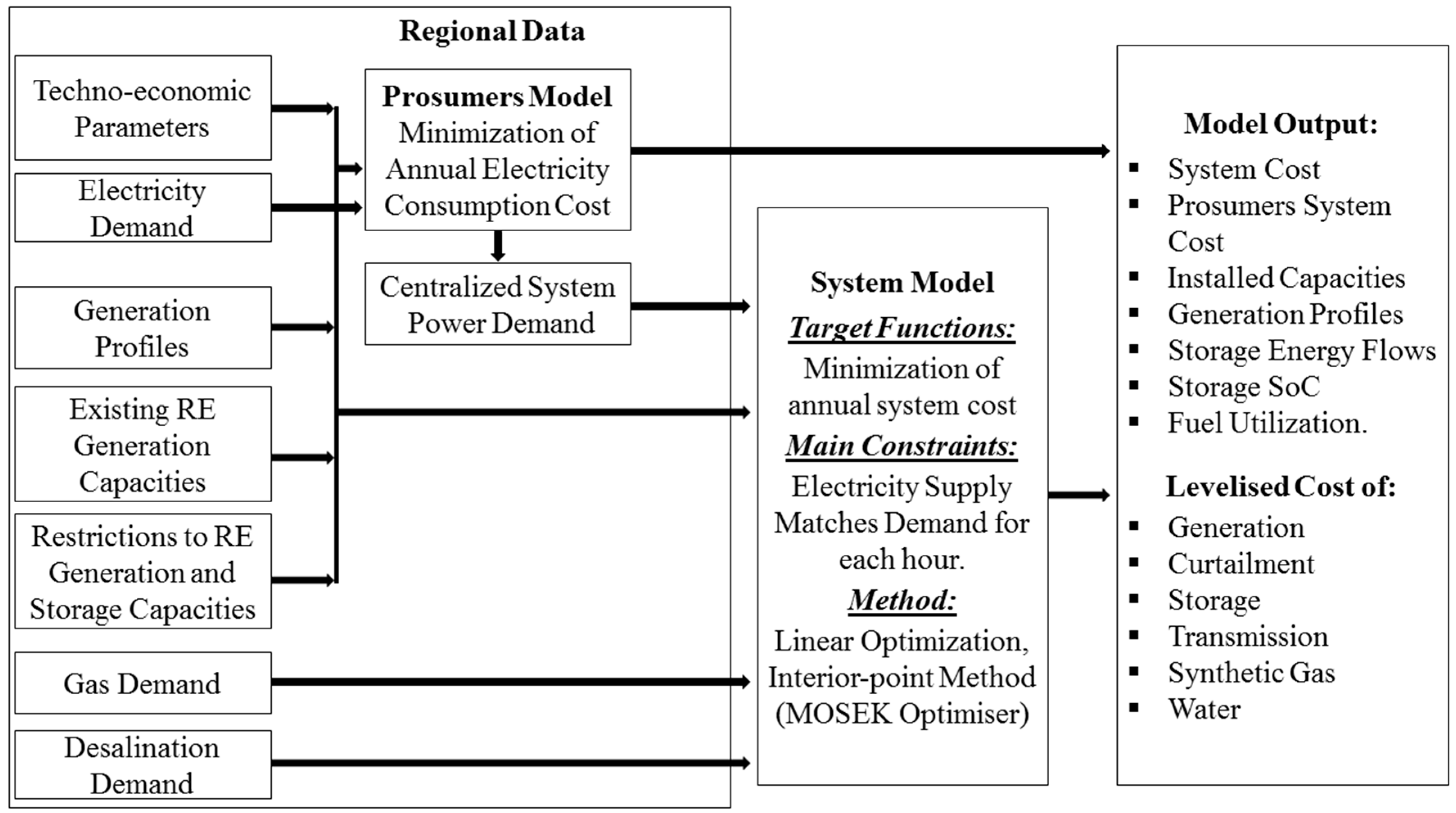
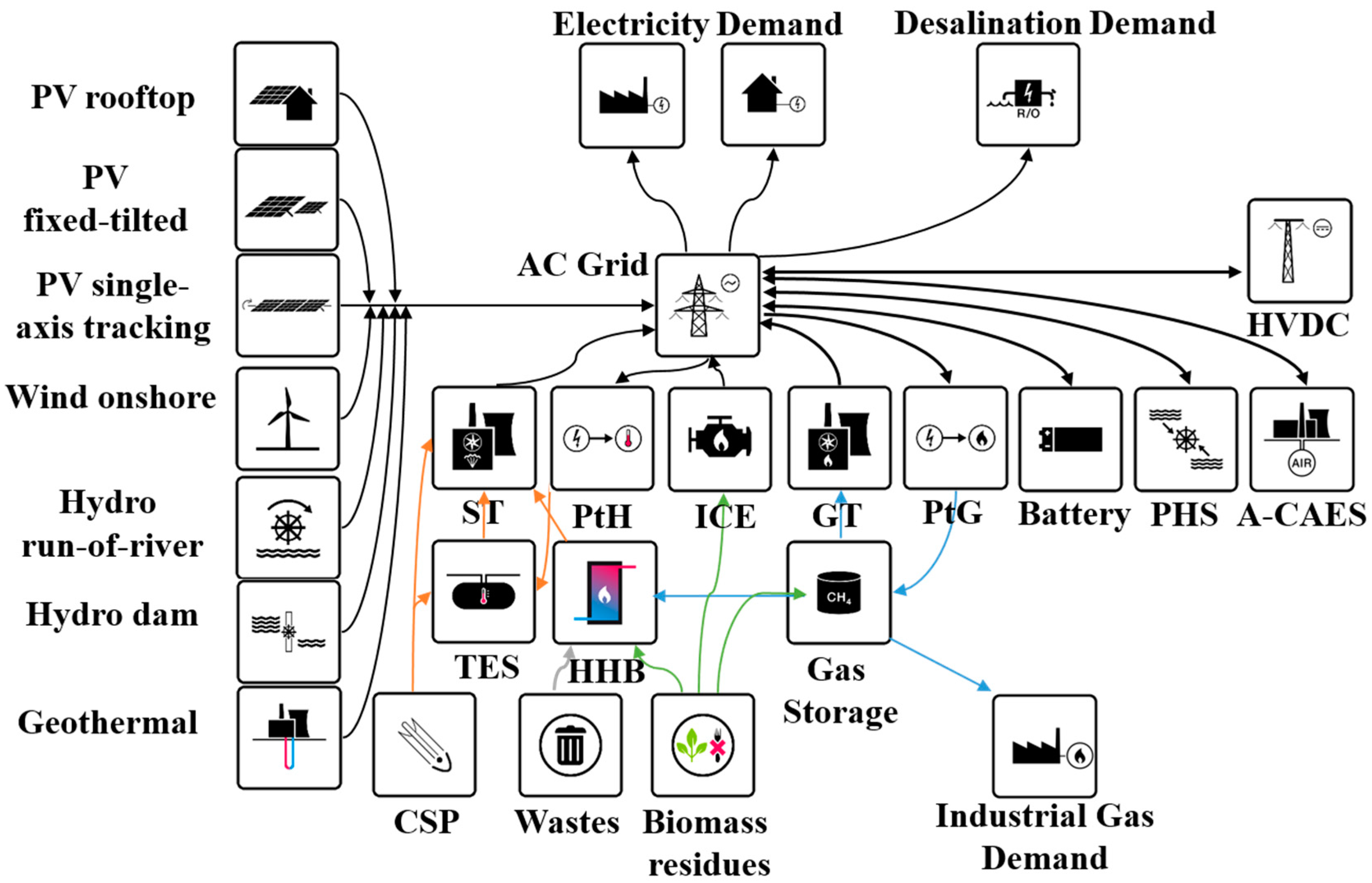
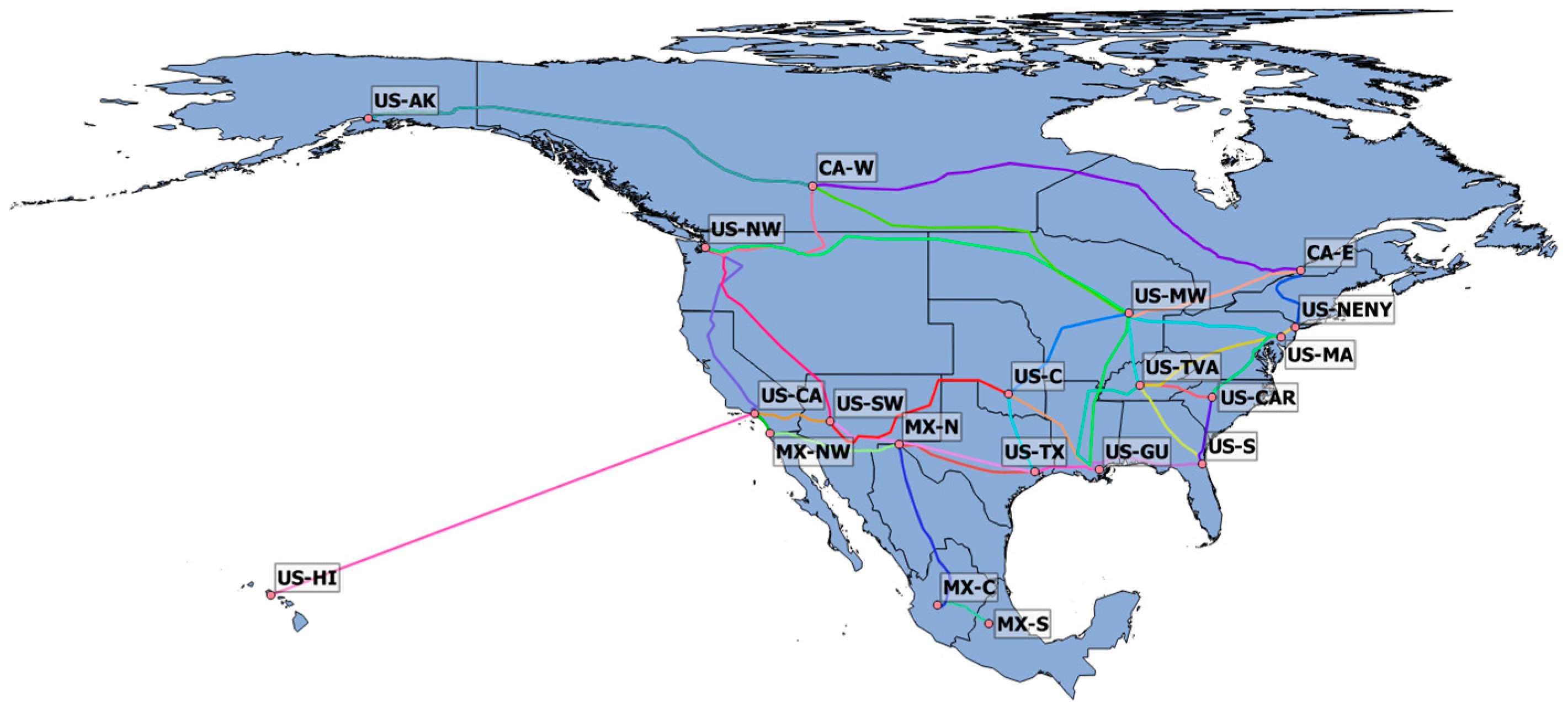
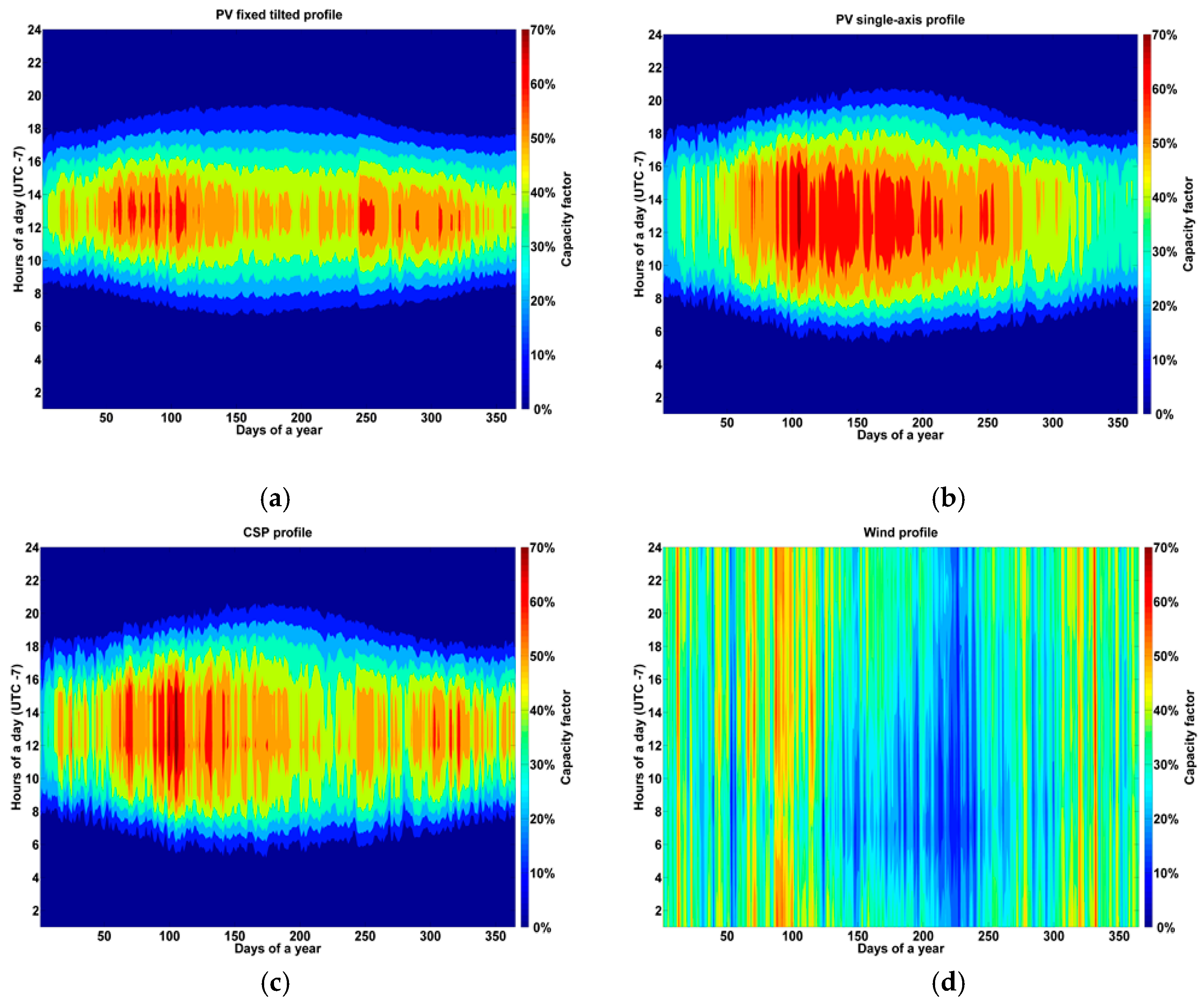
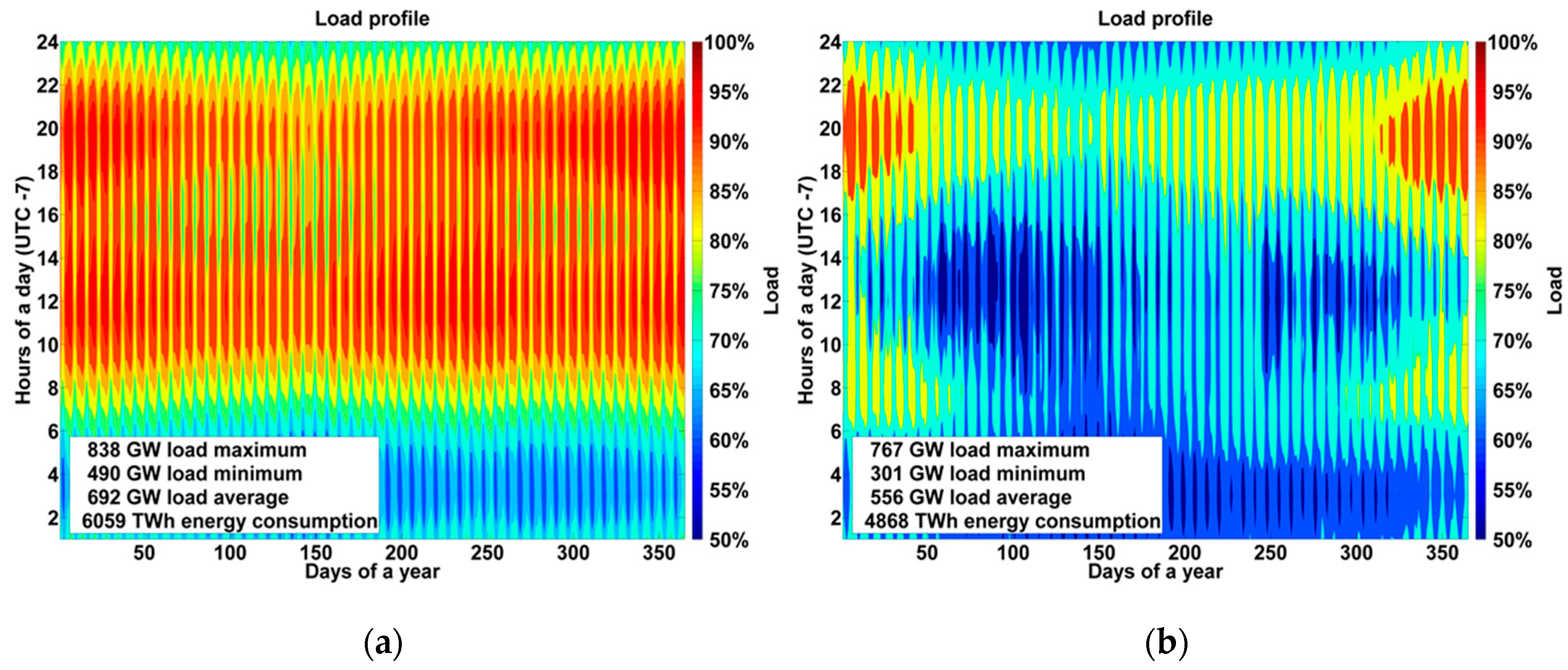
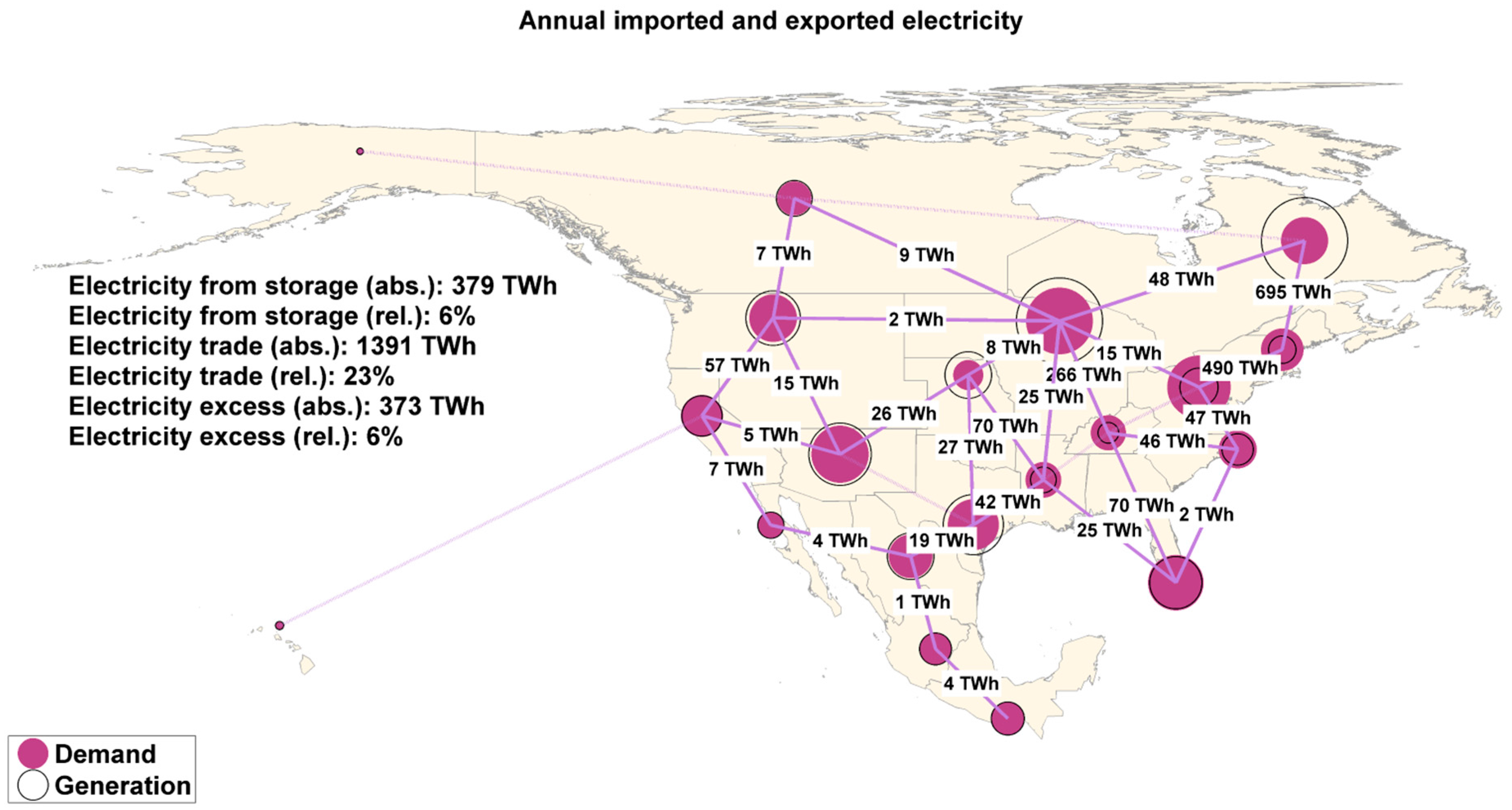

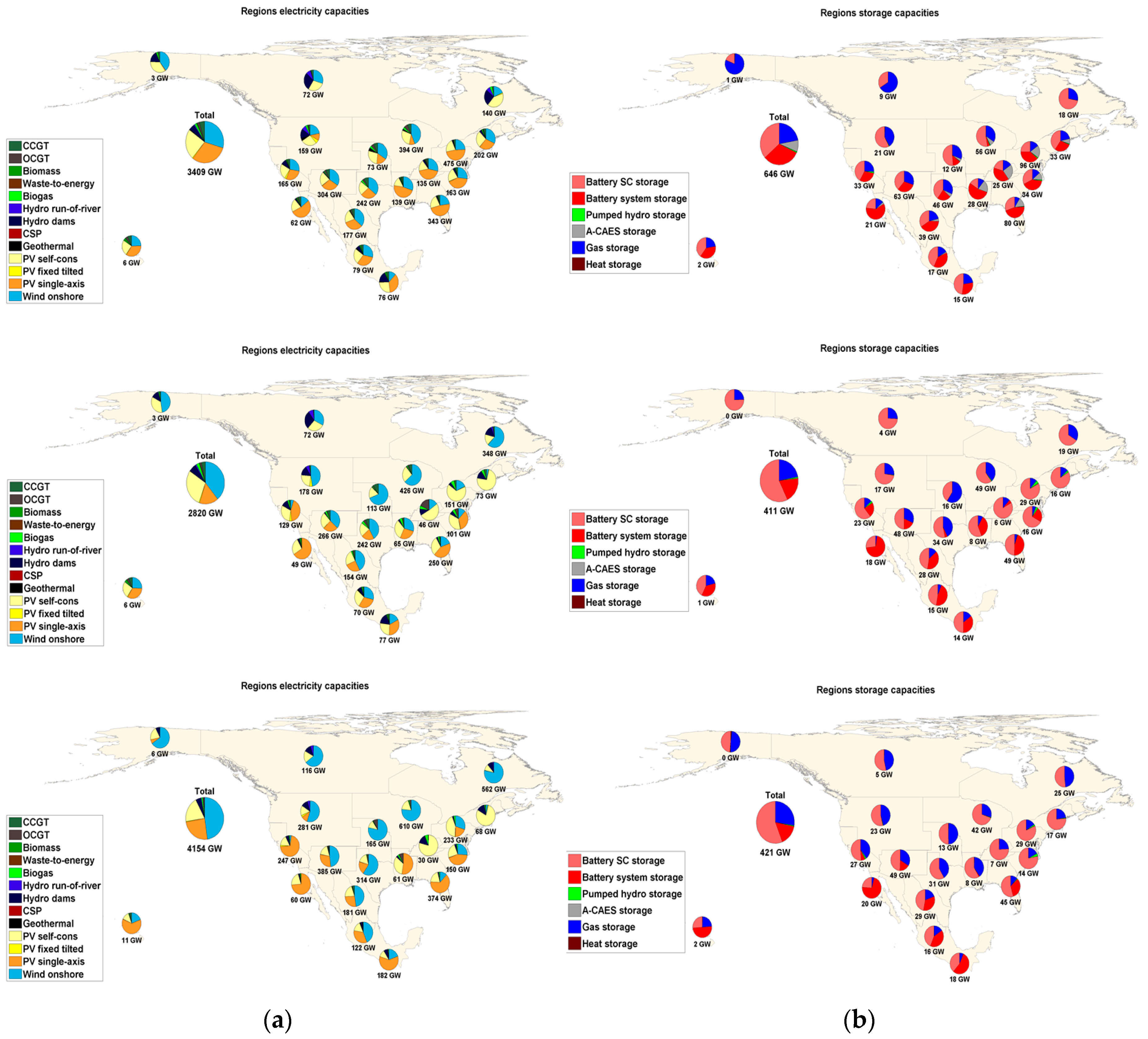
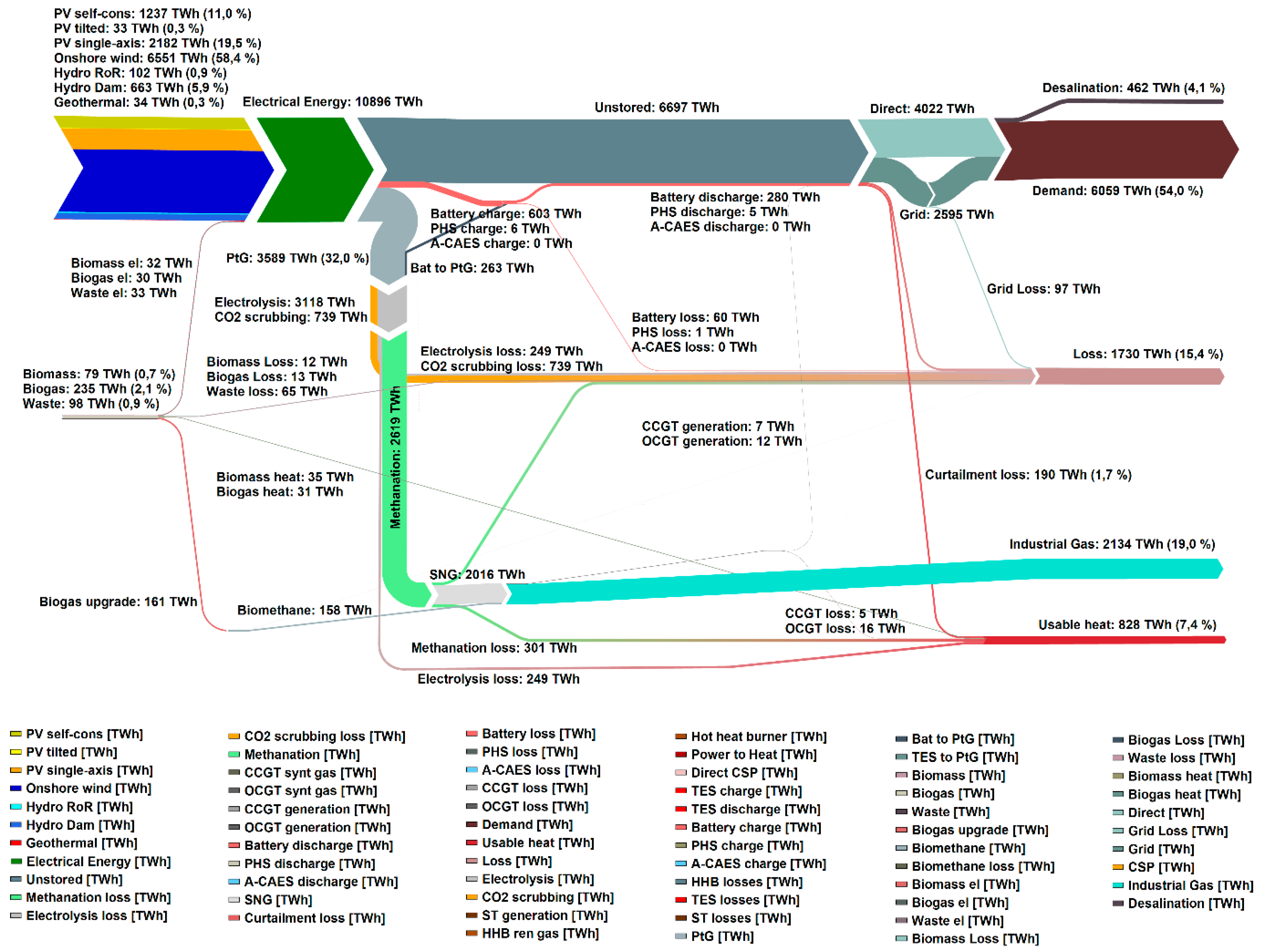

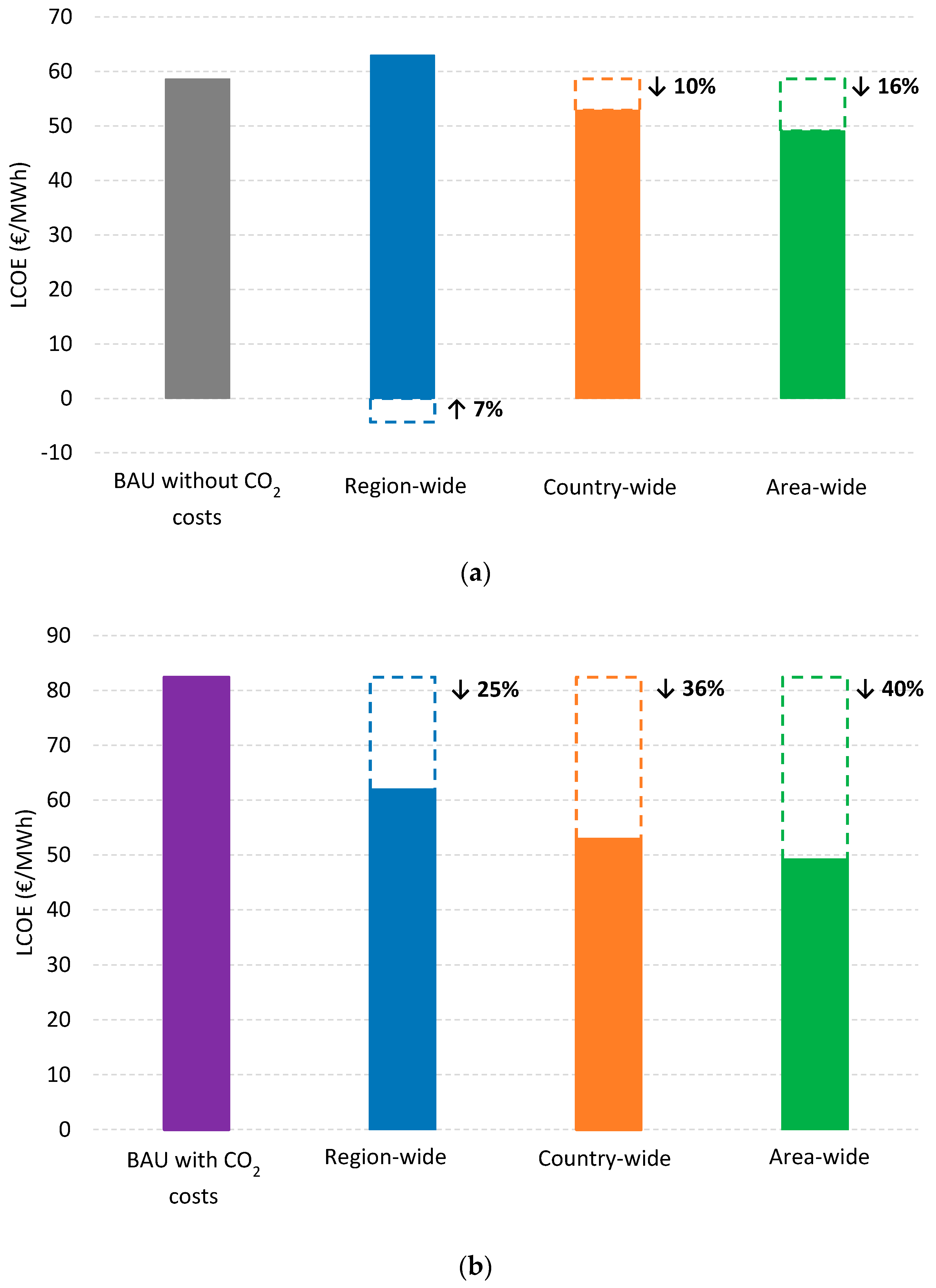
| Considered Scenarios | Total LCOE [€/MWh] | LCOE Primary [€/MWh] | LCOC [€/MWh] | LCOS [€/MWh] | LCOT [€/MWh] | Total Ann. Cost [b€] | Total CAPEX [b€] | RE Capacities [GW] | Generated Electricity [TWh] |
|---|---|---|---|---|---|---|---|---|---|
| Region-wide | 63 | 37 | 3 | 23 | 0 | 388 | 3502 | 3354 | 7207 |
| Country-wide | 56 | 36 | 2 | 15 | 3 | 341 | 3114 | 2941 | 7062 |
| Area-wide | 53 | 35 | 2 | 12 | 4 | 321 | 2945 | 2760 | 6861 |
| Integrated scenario | 42 | 33 | 1 | 5 | 3 | 498 | 4668 | 4152 | 10,975 |
| Technology | Unit | Region-Wide Scenario | Country-Wide Scenario | Area-Wide Scenario | Integrated Scenario |
|---|---|---|---|---|---|
| PV self-consumption | [GW] | 812 | 812 | 812 | 812 |
| PV optimally tilted | [GW] | 21 | 21 | 21 | 20 |
| PV single-axis tracking | [GW] | 1062 | 566 | 454 | 1018 |
| PV total | [GW] | 1895 | 1399 | 1286 | 1850 |
| CSP | [GW] | 0 | 0 | 0 | 0 |
| Wind energy | [GW] | 1005 | 1134 | 1097 | 1980 |
| Biomass power plants | [GW] | 22 | 14 | 8 | 4 |
| MSW incinerator | [GW] | 4 | 4 | 4 | 4 |
| Biogas power plants | [GW] | 52 | 68 | 68 | 46 |
| Geothermal power | [GW] | 19 | 5 | 5 | 5 |
| Hydro Run-of-River | [GW] | 29 | 29 | 29 | 26 |
| Hydro dams | [GW] | 158 | 168 | 178 | 178 |
| Battery PV self-consumption | [GWh] | 1411 | 1411 | 1411 | 1411 |
| Battery System | [GWh] | 1234 | 593 | 483 | 402 |
| Battery total | [GWh] | 2645 | 2004 | 1894 | 1813 |
| PHS | [GWh] | 35 | 35 | 35 | 25 |
| A-CAES | [GWh] | 5822 | 186 | 1 | 5 |
| Heat storage | [GWh] | 0 | 1 | 0 | 2 |
| PtG electrolysers | [GWel] | 114 | 84 | 54 | 442 |
| CCGT | [GW] | 159 | 133 | 103 | 9 |
| OCGT | [GW] | 65 | 77 | 42 | 55 |
| Steam Turbine | [GW] | 0 | 0 | 0 | 0 |
| Technology | Installed Capacity [GW] | Capex [€/kW] | Opex [€/kW] | LCOE [€/MWh] |
|---|---|---|---|---|
| Solar PV | 70 | 731 | 11 | 47 |
| CSP | 9 | 327 | 8 | 11 |
| Wind energy | 144 | 1000 | 20 | 38 |
| Biomass power plants | 31 | 2500 | 175 | 70 |
| Geothermal power | 7 | 4470 | 80 | 59 |
| Hydro Run-of-River | 41 | 2560 | 105 | 82 |
| Hydro dams | 176 | 1650 | 66 | 52 |
| Gas-fired power plants | 625 | 675 | 18 | 86 |
| Oil power plants | 30 | 500 | 10 | 491 |
| Diesel-fired power plants | 10 | 310 | 6 | 187 |
| Coal power plants | 349 | 1500 | 20 | 23 |
| Nuclear power plants | 123 | 5000 | 200 | 81 |
© 2017 by the authors. Licensee MDPI, Basel, Switzerland. This article is an open access article distributed under the terms and conditions of the Creative Commons Attribution (CC BY) license (http://creativecommons.org/licenses/by/4.0/).
Share and Cite
Aghahosseini, A.; Bogdanov, D.; Breyer, C. A Techno-Economic Study of an Entirely Renewable Energy-Based Power Supply for North America for 2030 Conditions. Energies 2017, 10, 1171. https://doi.org/10.3390/en10081171
Aghahosseini A, Bogdanov D, Breyer C. A Techno-Economic Study of an Entirely Renewable Energy-Based Power Supply for North America for 2030 Conditions. Energies. 2017; 10(8):1171. https://doi.org/10.3390/en10081171
Chicago/Turabian StyleAghahosseini, Arman, Dmitrii Bogdanov, and Christian Breyer. 2017. "A Techno-Economic Study of an Entirely Renewable Energy-Based Power Supply for North America for 2030 Conditions" Energies 10, no. 8: 1171. https://doi.org/10.3390/en10081171






